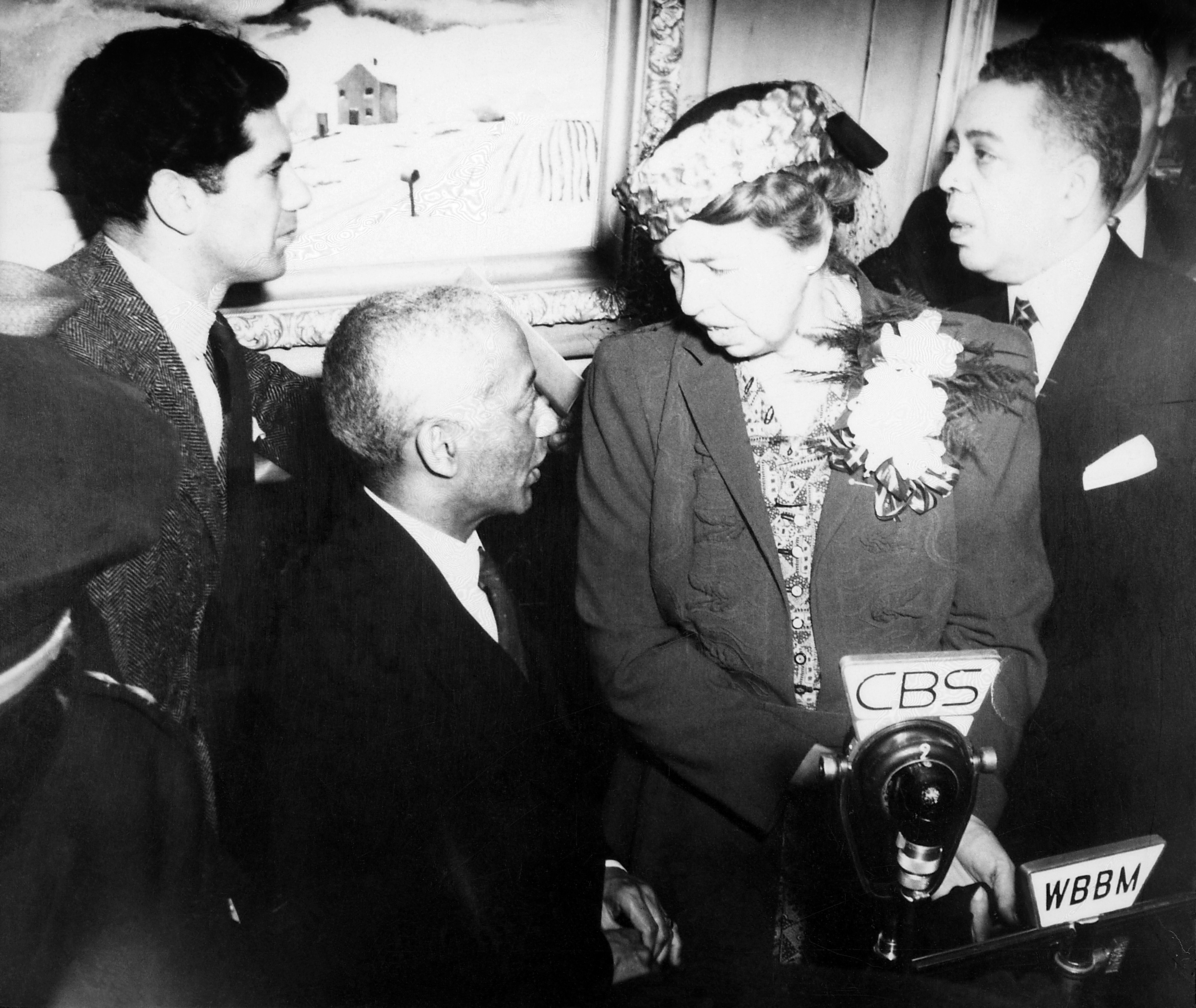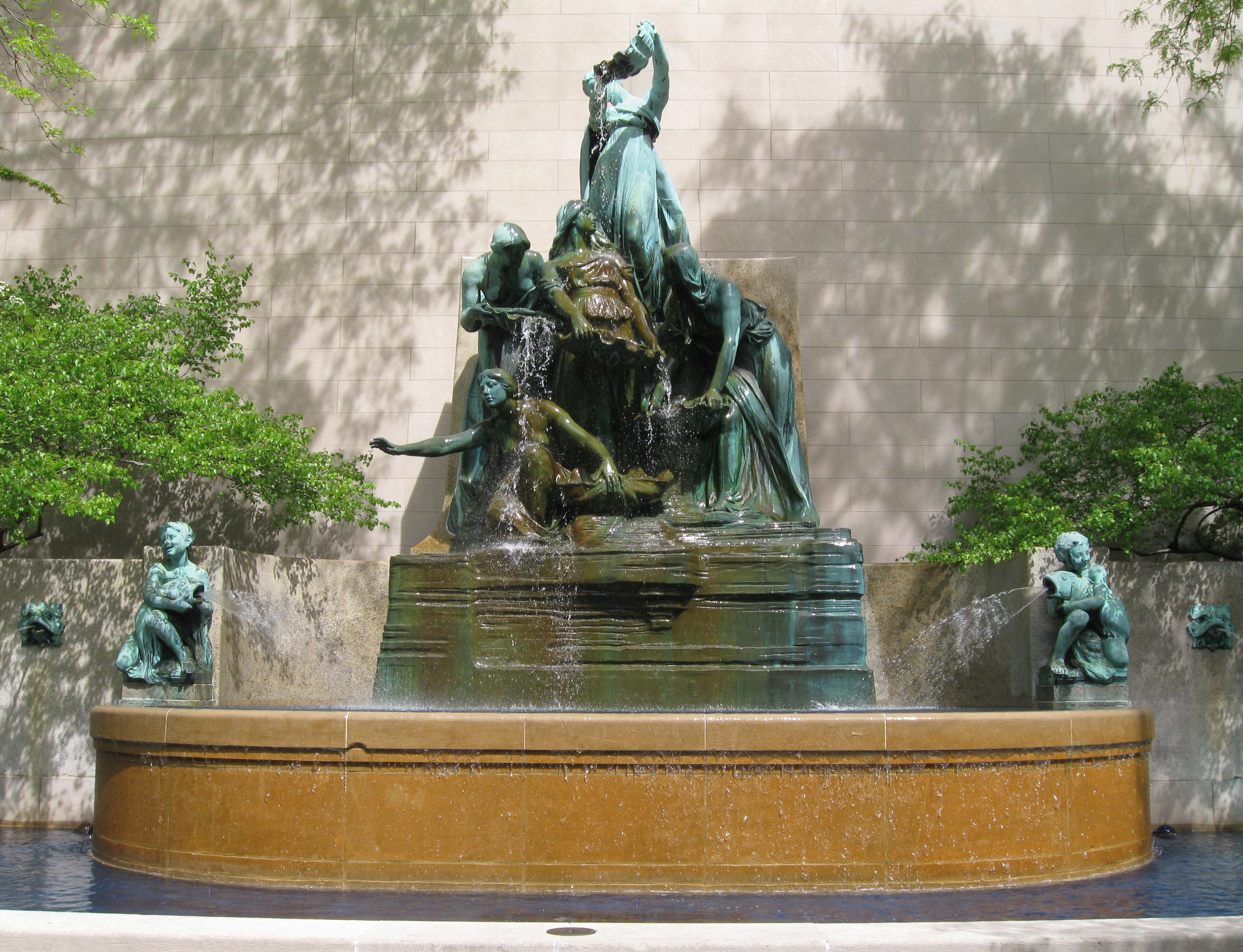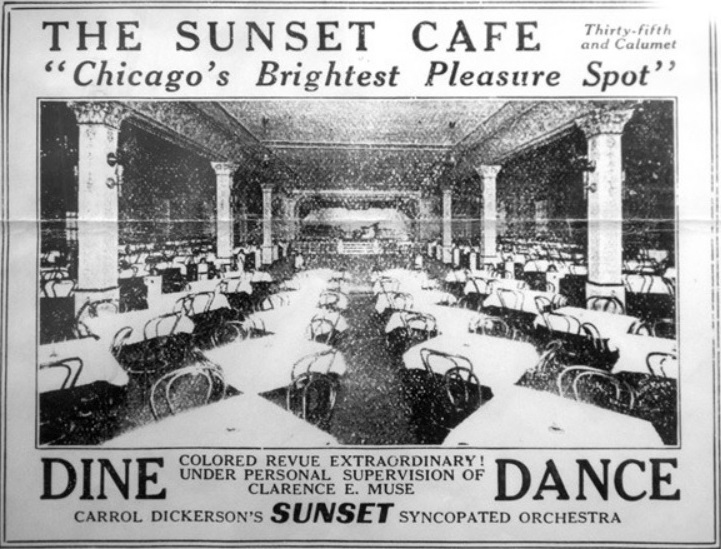|
Black Metropolis–Bronzeville District
The Black Metropolis–Bronzeville District is a historic African American district in the Bronzeville neighborhood of the Douglas community area on the South Side of Chicago, Illinois. The neighborhood encompasses the land between the Dan Ryan Expressway to the west, Martin Luther King Jr. Drive to the east, 31st Street to the north, and Pershing Road (39th street) to the south. The Bronzeville–Black Metropolis National Heritage Area was established in the National Heritage Area Act in 2022. The National Heritage Area will help preserve more than 200 locations in the neighborhood between 18th and 71st Streets. Description The historic district includes nine structures that were accorded the Chicago Landmark designation on September 9, 1998. These buildings are: * Overton Hygienic Building * Chicago Bee Building * Wabash Avenue YMCA * Chicago Defender Building * Unity Hall * Eighth Regiment Armory * Sunset Cafe * Victory Monument * Supreme Life Building. Six of th ... [...More Info...] [...Related Items...] OR: [Wikipedia] [Google] [Baidu] |
Bronzeville - 2
Bronzeville may refer to: * Another name for the Little Tokyo area of Los Angeles, during World War II * A neighborhood and district in Chicago, Illinois ** Black Metropolis-Bronzeville District, a historic district within the Bronzeville neighborhood * King-Lincoln Bronzeville, a neighborhood in Columbus, Ohio * A neighborhood in Milwaukee, Wisconsin * ''Bronzeville'' (play), a 2009 play by Tim Toyama and Aaron Woolfolk * ''Bronzeville'' (podcast), an audio drama by Larenz Tate and Laurence Fishburne {{disambiguation, geo ... [...More Info...] [...Related Items...] OR: [Wikipedia] [Google] [Baidu] |
Chicago Defender Building
The Chicago Defender Building is the former Jewish synagogue that housed the ''Chicago Defender'' from 1920 until 1960. It was designated a Chicago Landmark on September 9, 1998. The building is in the Black Metropolis-Bronzeville District in the Douglas community area of Chicago, Illinois Illinois ( ) is a U.S. state, state in the Midwestern United States, Midwestern United States. Its largest metropolitan areas include the Chicago metropolitan area, and the Metro East section, of Greater St. Louis. Other smaller metropolita ... at 3435 S. Indiana Ave. It was designed by Henry L. Newhouse. You can read more about the nine designated landmarks, including the Chicago Defender Building and Robert S. Abbott, the newspaper's publisher, in this document from the City of Chicago Department of Planning and DevelopmentThe Black Metropolis - Bronzeville District Gallery Image:20070601 Chicago Defender Building (3).JPG Image:20070601 Chicago Defender Building.JPG Notes ... [...More Info...] [...Related Items...] OR: [Wikipedia] [Google] [Baidu] |
Historic Districts In Chicago
History (derived ) is the systematic study and the documentation of the human activity. The time period of event before the invention of writing systems is considered prehistory. "History" is an umbrella term comprising past events as well as the memory, discovery, collection, organization, presentation, and interpretation of these events. Historians seek knowledge of the past using historical sources such as written documents, oral accounts, art and material artifacts, and ecological markers. History is not complete and still has debatable mysteries. History is also an academic discipline which uses narrative to describe, examine, question, and analyze past events, and investigate their patterns of cause and effect. Historians often debate which narrative best explains an event, as well as the significance of different causes and effects. Historians also debate the nature of history as an end in itself, as well as its usefulness to give perspective on the problems of the p ... [...More Info...] [...Related Items...] OR: [Wikipedia] [Google] [Baidu] |
Pekin Theatre
Established on June 18, 1905, Chicago’s Pekin Theatre was the first black owned musical and vaudeville stock theatre in the United States. Between 1905 and around 1915, the Pekin Club and its Pekin Theatre served as a training ground and showcase for Black theatrical talent, vaudeville acts, and musical comedies. Additionally, the theatre allowed “African-American theatre artists with an opportunity to master theater craft and contribute significantly to the development of an emerging Black theater tradition”. The Pekin became "renowned for its all-black stock company and school for actors, an orchestra able to play ragtime and opera with equal brilliance, and a repertoire of original musical comedies."Bauman, TThe Pekin: The Rise and Fall of Chicago's First Black-Owned Theater Champaign: University of Illinois Press, 2014. at Project MUSE Robert T Motts, founded the theatre, and brought it to prominence by presenting an all black company, seeking out an affluent interracia ... [...More Info...] [...Related Items...] OR: [Wikipedia] [Google] [Baidu] |
National Register Of Historic Places Listings In South Side Chicago
There are 103 sites on the National Register of Historic Places listings in South Side Chicago — of more than 350 total listings within the City of Chicago, in Cook County, Illinois. The South Side district is defined for this article as the area west of Lake Michigan, and south of 26th Street and the Chicago Sanitary and Ship Canal, to the southern Chicago city limits. South Side Chicago listings on the National Register The listed properties are distributed across 19 of the 77 well-defined community areas of Chicago. Former listing See also *List of Chicago Landmarks * **National Register of Historic Places listings in Central Chicago **National Register of Historic Places listings in North Side Chicago **National Register of Historic Places listings in West Side Chicago *List of Registered Historic Places in Illinois *List of National Historic Landmarks in Ill ... [...More Info...] [...Related Items...] OR: [Wikipedia] [Google] [Baidu] |
Black Metropolis
''Black Metropolis: A Study of Negro Life in a Northern City'', authored by St. Clair Drake and Horace R. Cayton, Jr., is an anthropological and sociological study of the African-American urban experience in the first half of the 20th century. Published in 1945, later expanded editions added some material relating to the 1950s and 1960s. Relying on massive research conducted in Chicago, primarily as part of a Works Progress Administration program, Drake and Cayton produced, according to the ''Encyclopedia of African American History'', a "foundational text in African American history, cultural studies, and urban sociology." Synopsis The original text begins with an introduction by novelist Richard Wright in which he relates some of the research to the themes of his work, particularly the novel, ''Native Son.'' The preface of the book, authored by Drake and Cayton, provides an overview of the Black Metropolis. The first section of the book then sketches the history of African- ... [...More Info...] [...Related Items...] OR: [Wikipedia] [Google] [Baidu] |
Victory Monument Chicago
The term victory (from Latin ''victoria'') originally applied to warfare, and denotes success achieved in personal Duel, combat, after military operations in general or, by extension, in any competition. Success in a military campaign constitutes a strategic victory, while the success in a Engagement (military), military engagement is a tactical victory. In terms of human emotion, victory accompanies strong feelings of elation, and in human behaviour often exhibits movements and poses paralleling threat display preceding the combat, which are associated with the excess endorphin built up preceding and during combat. Victory dances and victory cries similarly parallel war dances and battle cry, war cries performed before the outbreak of physical violence. Examples of victory behaviour reported in Roman antiquity, where the term ''victoria'' originated, include: the victory songs of the Batavi (Germanic tribe), Batavi mercenaries serving under Gaius Julius Civilis after the vic ... [...More Info...] [...Related Items...] OR: [Wikipedia] [Google] [Baidu] |
South Side Community Art Center
The South Side Community Art Center is a community art center in Chicago that opened in 1940 with support from the Works Progress Administration's Federal Art Project in Illinois. Opened in Bronzeville in an 1893 mansion, it became the first black art museum in the United States and has been an important center for the development Chicago's African American artists. Of more than 100 community art centers established by the WPA, this is the only one that remains open. The center was awarded Chicago Landmark status in 1994. Named a "National Treasure" by the National Trust for Historic Preservation in 2017, it was listed on the National Register of Historic Places in 2018. History Efforts to open a community art center on Chicago's South Side began in 1938. Peter Pollack, a Federal Art Project official, contacted Metz Lochard, an editor at the Chicago Defender, about having the Art Project sponsor exhibitions of African American artists, who often had trouble securing space to d ... [...More Info...] [...Related Items...] OR: [Wikipedia] [Google] [Baidu] |
National Register Of Historic Places
The National Register of Historic Places (NRHP) is the United States federal government's official list of districts, sites, buildings, structures and objects deemed worthy of preservation for their historical significance or "great artistic value". A property listed in the National Register, or located within a National Register Historic District, may qualify for tax incentives derived from the total value of expenses incurred in preserving the property. The passage of the National Historic Preservation Act (NHPA) in 1966 established the National Register and the process for adding properties to it. Of the more than one and a half million properties on the National Register, 95,000 are listed individually. The remainder are contributing resources within historic districts. For most of its history, the National Register has been administered by the National Park Service (NPS), an agency within the U.S. Department of the Interior. Its goals are to help property owners and inte ... [...More Info...] [...Related Items...] OR: [Wikipedia] [Google] [Baidu] |
Supreme Life Building
The Supreme Life Building is a historic insurance building located at 3501 S. Dr. Martin Luther King Drive in the Douglas community area of Chicago, Illinois. Built in 1921, the building served as the headquarters of the Supreme Life Insurance Company, which was founded two years earlier by Frank L. Gillespie. The company, originally known as the Liberty Life Insurance Company, was the first African-American owned insurance company in the northern United States. Since white-owned insurance firms regularly denied black customers life insurance when the firm was founded, the firm played an important role in providing life insurance to Chicago's African-American community. The company ultimately became the largest African-American owned business in the northern states and became a symbol of the predominantly black Bronzeville neighborhood's economic success from the 1920s to the 1950s. In the 1990s, the building was nearly demolished before it was purchased by the Black Metropolis C ... [...More Info...] [...Related Items...] OR: [Wikipedia] [Google] [Baidu] |
Victory Monument (Chicago)
Erected in 1927, the Victory Monument, is based on an idea by John A. Nyden, and was sculpted by Leonard Crunelle. It was built to honor the Eighth Regiment of the Illinois National Guard, an African-American unit that served in France during World War I. It is located in the Black Metropolis-Bronzeville District in the Douglas community area on the South Side of Chicago, Illinois. The structure was added to the National Register of Historic Places on April 30, 1986. It was designated a Chicago Landmark on September 9, 1998. An annual Memorial Day ceremony is held at the monument. Description and history The Smithsonian Institution’s Archives of American Art describes the monument: ::A white granite shaft topped with a bronze doughboy sculpture. On the monument's shaft are three bronze relief panels depicting life-sized figures. (Victory Panel:) Left full-length profile of a Classically draped African-American female figure representing motherhood. In her hand she holds a ... [...More Info...] [...Related Items...] OR: [Wikipedia] [Google] [Baidu] |
Sunset Cafe
The Sunset Cafe, also known as The Grand Terrace Cafe, was a jazz club in Chicago, Illinois operating during the 1920s, 1930s and 1940s. It was one of the most important jazz clubs in America, especially during the period between 1917 and 1928 when Chicago became a creative capital of jazz innovation and again during the emergence of bebop in the early 1940s. From its inception, the club was a rarity as a haven from segregation, since the Sunset Cafe was an integrated or "Black and Tan" club where African Americans, along with other ethnicities, could mingle freely with white Americans without much fear of reprisal. Many important musicians developed their careers at the Sunset/Grand Terrace Cafe. Original building The building that housed the Cafe still stands at 315 E 35th St in the Bronzeville neighborhood of Chicago. Originally built in 1909 as an automobile garage, after a 1921 remodelling it became a venue with around 100 tables, a bandstand and dance floor. While the hist ... [...More Info...] [...Related Items...] OR: [Wikipedia] [Google] [Baidu] |
.jpg)




